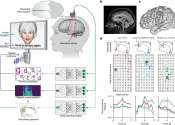Artificial intelligence still lags behind humans at recognising emotions
When it comes to reading emotions on people's faces, artificial intelligence still lags behind human observers, according to a new study involving UCL.
Apr 30, 2020
2
240
Machine learning & AI

When it comes to reading emotions on people's faces, artificial intelligence still lags behind human observers, according to a new study involving UCL.
Apr 30, 2020
2
240
Computer Sciences

A novel artificial intelligence (AI) approach based on wireless signals could help to reveal our inner emotions, according to new research from Queen Mary University of London.
Feb 3, 2021
0
238
Software

Researchers at UC San Francisco and UC Berkeley have developed a brain-computer interface (BCI) that has enabled a woman with severe paralysis from a brainstem stroke to speak through a digital avatar.
Aug 23, 2023
0
136
Computer Sciences

Researchers at the Polish-Japanese Academy of Information Technology and Warsaw University of Technology have developed a deep alignment network (DAN) model to classify and visualize emotions. Their method was found to outperform ...
Computer Sciences

Computer scientists at UC Riverside can detect manipulated facial expressions in deepfake videos with higher accuracy than current state-of-the-art methods. The method also works as well as current methods in cases where ...
May 4, 2022
0
214
Machine learning & AI

Researchers at Stanford have recently explored the use of machine learning to measure the severity of depressive symptoms by analyzing people's spoken language and 3-D facial expressions. Their multi-model method, outlined ...
Hardware

A joint research team led by Professors Ki-Hun Jeong and Doheon Lee from the KAIST Department of Bio and Brain Engineering reported the development of a technique for facial expression detection by merging near-infrared light-field ...
Jan 21, 2022
1
37
Computer Sciences

In recent years, computer scientists have developed a broad variety of virtual agents, artificial agents designed to interact with humans or assist them with various tasks. Some past findings suggest that the extent to which ...
Engineering

Using a miniature camera and a customized deep neural network, Cornell researchers have developed a first-of-its-kind wristband that tracks the entire body posture in 3D.
Nov 8, 2022
0
115
Robotics

While our facial expressions play a huge role in building trust, most robots still sport the blank and static visage of a professional poker player. With the increasing use of robots in locations where robots and humans need ...
May 27, 2021
0
23
A facial expression results from one or more motions or positions of the muscles of the face. These movements convey the emotional state of the individual to observers. Facial expressions are a form of nonverbal communication. They are a primary means of conveying social information among humans, but also occur in most other mammals and some other animal species.
Humans can adopt a facial expression as a voluntary action. However, because expressions are closely tied to emotion, they are more often involuntary. It can be nearly impossible to avoid expressions for certain emotions, even when it would be strongly desirable to do so; a person who is trying to avoid insult to an individual he or she finds highly unattractive might nevertheless show a brief expression of disgust before being able to reassume a neutral expression. The close link between emotion and expression can also work in the other direction; it has been observed that voluntarily assuming an expression can actually cause the associated emotion.[citation needed]
Some expressions can be accurately interpreted even between members of different species- anger and extreme contentment being the primary examples. Others, however, are difficult to interpret even in familiar individuals. For instance, disgust and fear can be tough to tell apart.[citation needed]
Because faces have only a limited range of movement, expressions rely upon fairly minuscule differences in the proportion and relative position of facial features, and reading them requires considerable sensitivity to same. Some faces are often falsely read as expressing some emotion, even when they are neutral, because their proportions naturally resemble those another face would temporarily assume when emoting.[citation needed]
This text uses material from Wikipedia, licensed under CC BY-SA